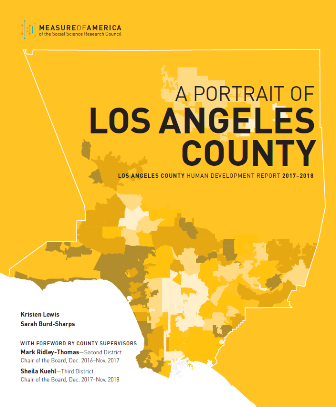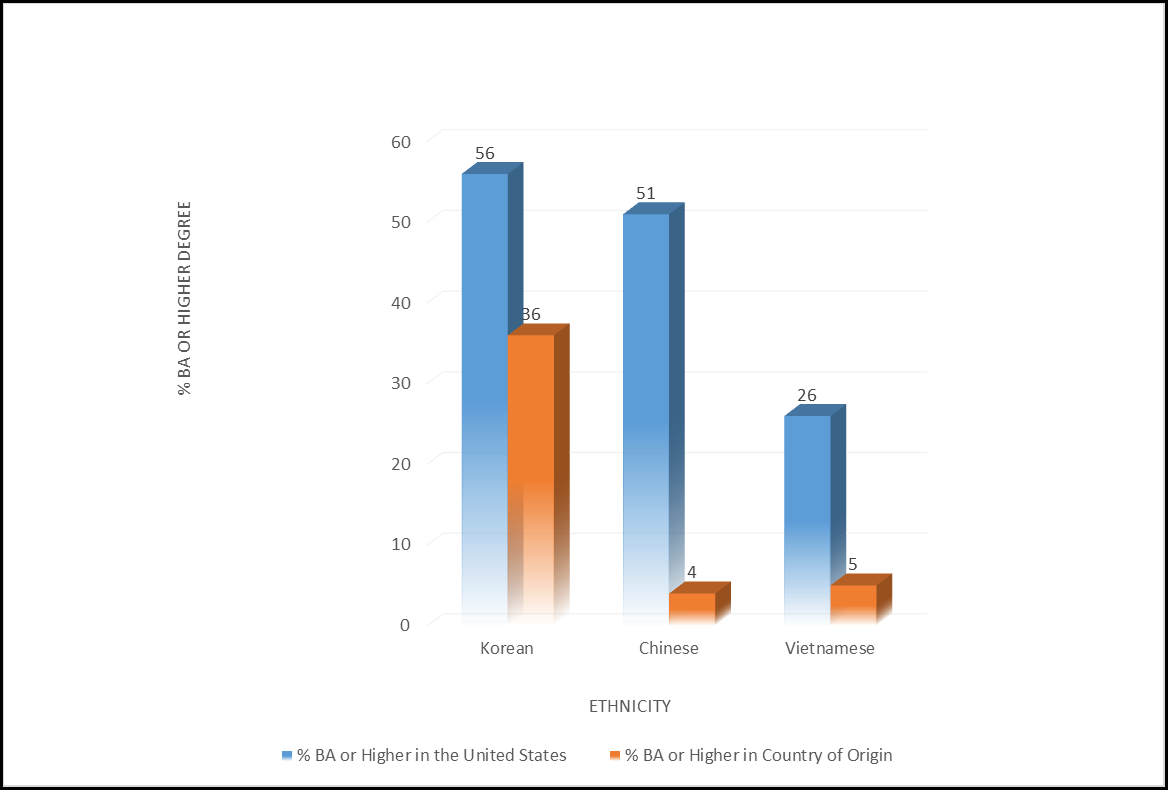Americans rely on status markers like our college degrees, jobs, cars, homes, zip codes, and (if you live in Los Angeles) area codes to measure success. We also like to believe that those who are successful earned it through hard work, smarts, and grit. After all, this is what we learned from the American Dream, and it is how we justify why some people and groups are more successful than others.
Take education, for example. In Los Angeles, Asians graduate from college at higher rates than all groups, including Whites. More than half (51 percent) of Asians in LA have at least a college degree compared to 48 percent of whites, 26 percent of blacks, and 12 percent of Latinos.1Kristen Lewis and Sarah Burd-Sharps, A Portrait of Los Angeles County: Los Angeles County Human Development Report 2017–2018 (Social Science Research Council, 2017), 87. Most of us are no longer surprised by findings like these. We hear and read about the exceptional educational outcomes of Asian Americans when colleges and universities—especially Ivy Leagues—release their latest admissions figures.
“These figures would be unremarkable if Asian American students uniformly hailed from high socioeconomic backgrounds, but this is not the case.”Asian Americans make up more than one-fifth of the entering classes in Ivy League universities like Harvard, Yale, Princeton, and Columbia yet are only 6 percent of the country’s population. In prestigious public universities like the University of California, Berkeley, they comprise more than 40 percent of the student body. These figures would be unremarkable if Asian American students uniformly hailed from high socioeconomic backgrounds, but this is not the case. Even the children of Chinese immigrants and Vietnamese refugees whose parents have less than a high school education graduate from college at nearly the same rate as their middle-class peers, pointing to a vexing Asian American achievement paradox.
Unable to explain the achievement paradox, pundits and commentators of varying political persuasions point to Asian culture2Patricia Fernández-Kelly, “Fixing the Cultural Fallacy,” Ethnic and Racial Studies 39, no. 13 (2016): 2372-2378.: there must be something essential about Asian culture that drives such extraordinary educational outcomes. New York Times columnist Nicholas Kristof devoted a Sunday column to the so-called “The Asian Advantage.” He even cited our book, The Asian American Achievement Paradox,3 Russell Sage Foundation, 2015More Info → but in the end, Kristof concluded that Asian American academic achievement can be explained by “East Asia’s long Confucian emphasis on education,” “hard work, strong families and passion for education.” How else could the daughter of poorly educated Chinese factory workers raised in an impoverished neighborhood buck the odds and graduate from Harvard?
Russell Sage Foundation, 2015More Info → but in the end, Kristof concluded that Asian American academic achievement can be explained by “East Asia’s long Confucian emphasis on education,” “hard work, strong families and passion for education.” How else could the daughter of poorly educated Chinese factory workers raised in an impoverished neighborhood buck the odds and graduate from Harvard?
Disaggregating Asian: Not all Asians excel
As compelling as this narrative may be, it misses the mark. The cultural roots of Asian success are much less plausible when disaggregating the category of “Asian.” Drawing on Measure of America’s report, A Portrait of Los Angeles County,4 Social Science Research Council, 2017More Info → examining differences among and within Asian ethnic groups complicates the stereotypical view of Asian American educational success in two key ways.
Social Science Research Council, 2017More Info → examining differences among and within Asian ethnic groups complicates the stereotypical view of Asian American educational success in two key ways.
First, not all Asian groups—even those who share a Confucian orientation—boast high levels of education. For example, while 72 percent of Indians, 53 percent of Koreans, and 49 percent of Chinese in LA have earned a bachelor’s degree or higher, the corresponding figures for Vietnamese and Cambodians is 30 percent and 18 percent, respectively. Moreover, about one-third of Vietnamese (30 percent) and Cambodians (36 percent) and nearly one-fifth of Chinese (18 percent) do not have a high school diploma.5Lewis and Burd-Sharps, A Portrait of Los Angeles County, 88. Disaggregating data highlights the enormously diverse outcomes among Asian Americans, who are often studied as a monolith.
Second, international comparisons are useful points of reference. If culture can explain the high achievement of some Asian groups, then we should expect these groups to excel in the greater United States and abroad, but this is not the case. While Koreans in the United States exhibit high educational outcomes, Koreans in Japan fare poorly. Moreover, unlike second-generation Chinese in the United States, their counterparts in Spain exhibit the lowest educational aspirations and expectations of all groups, as Alejandro Portes and his colleagues have shown with their research.6 University of California Press, 2016More Info → Despite the disconfirming evidence, culturally essentialist explanations that point to Asian culture and values thrive in popular discourse.
University of California Press, 2016More Info → Despite the disconfirming evidence, culturally essentialist explanations that point to Asian culture and values thrive in popular discourse.
The hyper-selectivity of Asian immigration
In our book, The Asian American Achievement Paradox, Min Zhou and I tackle this argument head on, and assert that there is nothing essential about Asian culture or values that promote exceptional academic outcomes. Rather, the cultural manifestations of Asian American achievement have legal and structural roots—namely the change in US immigration law in 1965 that altered the socioeconomic profiles of Asian immigrants. Privileging those with high levels of education and skills, the Immigration and Naturalization Act of 1965 ushered in a stream of highly educated, highly skilled immigrants from Asia.
The change in immigration law explains why contemporary Asian immigrants are, on average, highly educated and highly selected. For example, 51 percent of US Chinese immigrants have a college degree compared to only 4 percent of adults in China, meaning that Chinese immigrants in the United States are more than 12 times as likely to have graduated from college as their non-migrant counterparts. In addition, they are more highly educated than the general US population, 28 percent of whom are college-educated. We refer to this dual positive immigrant selectivity as hyper-selectivity, and as figure 1 shows, we find similar patterns for Korean immigrants in the United States. While Vietnamese immigrants are less likely to have graduated from college than the US mean, they are still positively selected compared to their non-migrant counterparts.
Figure 1: Educational achievement by ethnicity

The success frame for achievement
Hyper-selectivity has both direct and spillover effects. First, hyper-selected immigrants import class-specific cultural frames, institutions, and mindsets from their countries of origin, including a strict success frame. The frame not only spells out a clear definition of success, but it also lays out a clear pathway to achieve it.
The success frame entails earning straight As, graduating as the high school valedictorian, getting into a top school (defined as a University of California campus or an Ivy League school), and then working in one of four professions—medicine, law, science, or engineering. In metropolitan areas like Los Angeles and San Francisco that have witnessed a steady influx of hyper-selected Asian immigrants, grades are recalibrated on an “Asian scale” such that an A-minus is an “Asian F.”7 University of California Press, 2017More Info →
University of California Press, 2017More Info →
Second, the success frame is supported by supplementary education programs that hyper-selected immigrants import from their countries of origin and recreate in the United States. Chinese, Korean, and Indian immigrants come armed with the human capital and economic resources to create ethnic institutions like after-school academies, tutoring services, and SAT prep courses for their children that boost academic outcomes.
Third, because hyper-selected immigrant groups recreate these ethnic institutions in a range of price points—some of which are freely available in ethnic churches, temples, and community centers—they reach the children of working-class coethnics. Thus, supplementary education (which is typically reserved for affluent and middle-class children) becomes available to the children of factory workers, waiters, manicurists, and taxi drivers.
“These are the spillover effects of hyper-selectivity that help to explain how the daughter of Chinese factory workers who have only a sixth-grade education and do not speak English makes it into Harvard.”Here, working-class children and parents learn about the importance of enrolling in Advanced Placement and Honors classes, when to begin preparing for the SAT exam (which some children begin in seventh grade so that they are fully prepared to take the exam in the eleventh grade), and how to navigate the complex college admissions process.8Van C. Tran, “Ethnic Culture and Social Mobility among Second-Generation Asian Americans,” Ethnic and Racial Studies 39, no. 13 (2016): 2398–2403. These are the spillover effects of hyper-selectivity that help to explain how the daughter of Chinese factory workers who have only a sixth-grade education and do not speak English makes it into Harvard. This is not to deny the hard work, smarts, and grit on the part of students who make it to college, but, rather, a reminder that not all those who work hard, are smart, and demonstrate grit have the same chance of making it.
The hypo-selectivity of Latino immigration
Whenever I give public lectures on Asian American achievement, I often get questions about why Latinos do not form ethnic institutions like Asians. People point to ethnic institutions like after-school programs, and wonder why Latinos—and specifically Mexicans—fail to follow suit. To address this point, I explain that unlike Chinese immigrants, Mexican immigrants are hypo-selected: they are less likely to have graduated from college than their non-migrant counterparts and less likely to be college-educated than the US mean. Only 5 percent of Mexican immigrants have graduated from college, compared to 17 percent of Mexico’s adult population and 28 percent of the US population. This dual negative selectivity is what we refer to as hypo-selectivity. In figure 2, we show how the hypo-selectivity of Mexican immigration compares to the hyper-selectivity of Chinese immigration.
Figure 2: Hypo- and hyper-selectivity

As hypo-selected immigrants, Mexicans lack the resources to build the ethnic institutions that would assuage their children’s disadvantaged starting point, including, in some cases, their parents’ undocumented legal status.
Redefining success
Comparing Latinos to Asians points to yet another problem with the way we measure success. When we compare groups to each other, we overlook the remarkable progress that the children of Mexican immigrants in LA have made. Our research shows that in just one generation, they double the high school graduation rates of their parents, double the college graduation rates of their fathers, and triple that of their mothers.
This is also the case of Latinos in LA more generally, as Measure of America’s report reveals. While Latinos in LA have the lowest educational outcomes of all groups, when we disaggregate the data by nativity, we find significant differences between Latino immigrants and those born in the United States. More than half of Latino immigrants (55 percent) have not graduated from high school, and only 7 percent have graduated from college. US-born Latinos in LA look remarkably different: they are nearly three times as likely to graduate from high school and more than two and a half times as likely to graduate from college as Latino immigrants.9Lewis and Burd-Sharps, A Portrait of Los Angeles County, 89. The educational mobility of Latinos in LA is astounding, but this point is completely lost when we compare Latinos to Asians.
Many Americans work hard, are smart, and exhibit grit in spades. In spite of this, Americans will not graduate from college at the same rates because we begin the race at different points on the starting line. Moreover, some Americans get extra boosts during the race to help them speed across the finish line. So before we measure someone’s success by their diplomas, jobs, or zip codes, let’s first ask about the diplomas, jobs, and zip codes that came before them.














Comments are closed.